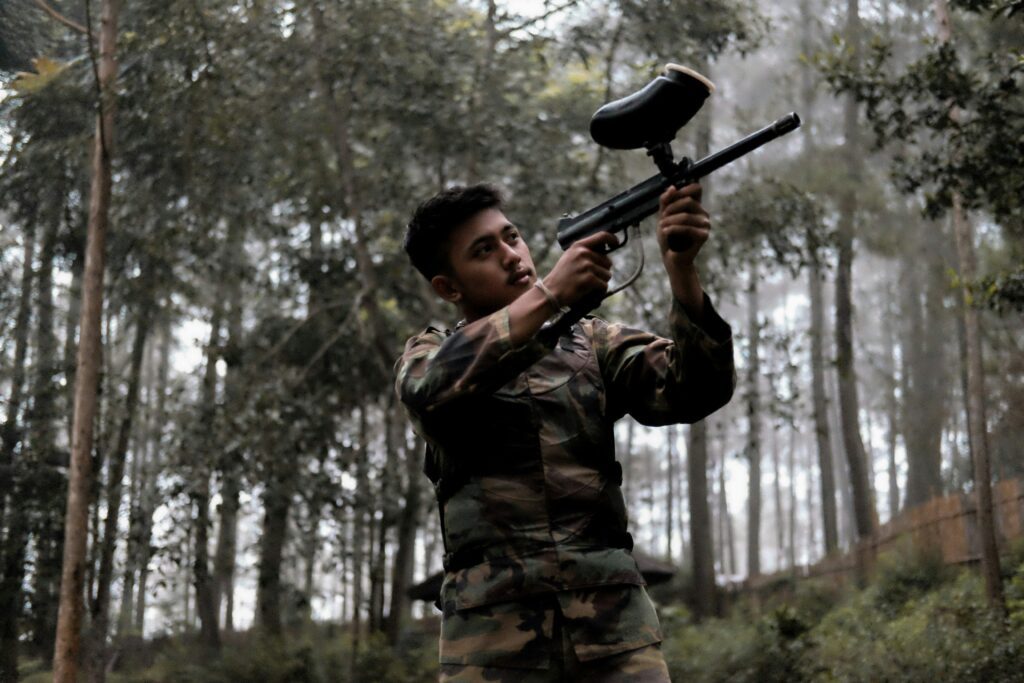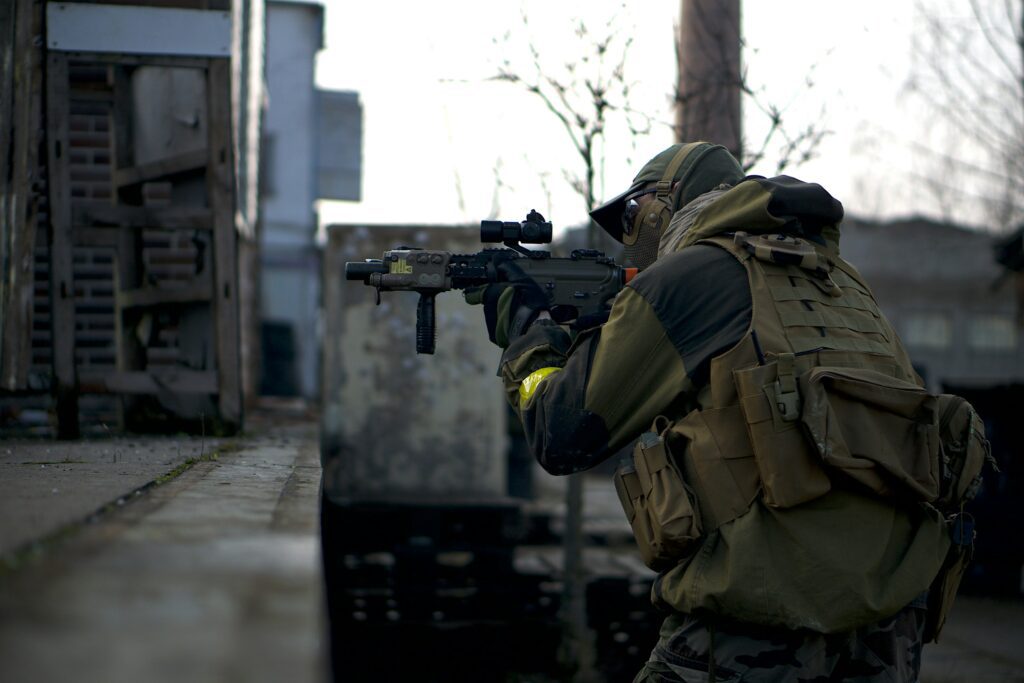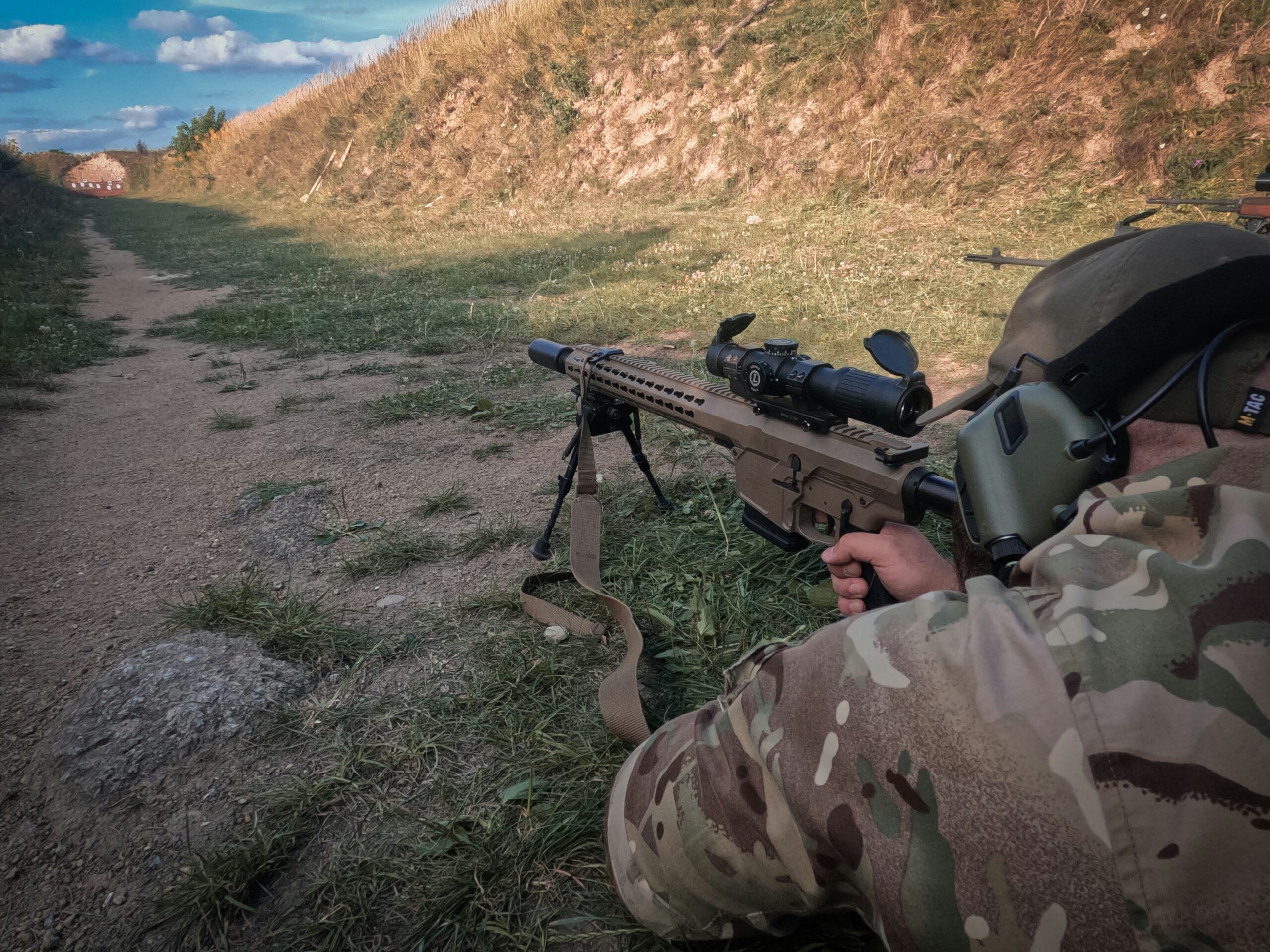Intro to Shooting for Accuracy
Marksmanship is more than just hitting a target; it’s about precision, control, and consistency, whether you’re in a competitive arena or a practical shooting scenario.
Understanding and mastering the art of shooting accurately is essential for anyone looking to excel in these areas.
This post is designed to guide you through achieving shooting accuracy, delving into what constitutes good marksmanship, the best firing positions for stability, ideal target selection, and the underlying fundamentals that form the bedrock of sharpshooting skills.
We’ll start by exploring the essence of good marksmanship, highlighting the blend of mental focus and physical technique required.
From there, we’ll share techniques and tips to enhance your accuracy, discuss the four standard rifle-firing positions, and help you choose targets that align with your training goals.
The fundamentals of marksmanship will break down the critical components of accurate shooting, followed by practical drills and exercises to refine these skills.
Additionally, we’ll cover the importance of proper equipment and maintenance, and how learning from experienced shooters can accelerate your journey towards becoming a proficient marksman. Join us as we embark on this path to precision shooting and marksmanship mastery.
The Essence of Good Marksmanship

Good marksmanship is defined by three key elements: consistency, accuracy, and control. It’s the ability to hit your target reliably, under various conditions, and with precise control over every shot fired.
Achieving this level of proficiency requires a blend of mental focus and physical discipline, making marksmanship as much about mental conditioning as it is about physical skill.
The mental aspects of marksmanship involve focus, patience, and the ability to remain calm under pressure. A marksman must be able to concentrate on their aim and execution while tuning out distractions.
Physically, it’s about mastering the fundamentals—proper stance, grip, sighting, and breath control. Developing muscle memory through repetition and practice is crucial, as is maintaining a stable shooting position.
Together, these mental and physical practices form the foundation of what makes a good marksman: someone who can consistently hit their mark with precision and control.
Shooting for Accuracy: Techniques and Tips
Improving shooting accuracy involves a comprehensive approach that combines sighting techniques, breath control, and trigger discipline. Here’s how to refine these skills for enhanced precision:
Sighting Techniques: Proper alignment of the sights is crucial. Focus on aligning the front and rear sights with your target, ensuring a clear sight picture. Practice this alignment consistently to improve accuracy.
Breath Control: Your breathing can significantly impact your stability and accuracy. Learn to shoot at the natural pause between inhalation and exhalation, when your body is most stable.
Trigger Discipline: Develop a smooth trigger pull by applying steady pressure until the shot fires, avoiding jerking or snapping movements that can throw off your aim.
Regular practice is key to mastering these techniques. Set aside consistent training time, focusing on quality over quantity. Use drills that replicate real-life scenarios to hone your skills under different conditions.
Setting realistic improvement goals is also vital. Start by assessing your current skill level and identify specific areas for improvement. Set achievable milestones and track your progress over time. Celebrate improvements, no matter how small, and adjust your goals as you advance.
Remember, accuracy in shooting is a journey, not a destination. Stay patient, dedicated, and open to learning from each practice session, and you’ll see your precision steadily improve.
Also Read: The Most Accurate Paintball Guns
Four Standard Rifle-Firing Positions

The four standard rifle-firing positions each offer unique advantages and challenges. Mastering these can significantly improve your shooting accuracy:
Prone: Lying flat on your stomach, the prone position is the most stable due to the wide support base and low center of gravity. It’s ideal for long-distance shooting, as it minimizes body movement. However, it might not always be practical in environments with obstructed views.
Standing: The most challenging due to the lack of support, the standing position requires strong core muscles and balance. It’s useful when you need a quick shot without the time to assume a more stable position. Practice can greatly improve steadiness in this stance.
Kneeling: Offering a good balance between stability and mobility, the kneeling position allows for quick setup and decent support, especially when using your knee as a rest for your supporting arm. It’s less stable than prone or sitting but more versatile in varied terrains.
Sitting: This position provides a stable shooting platform by lowering your center of gravity and using your legs to support your arms. It’s more comfortable for extended periods than kneeling and can be adjusted for different terrains.
Choosing the steadiest position depends on the shooting environment, the target’s distance, and your physical comfort. For long-range targets with clear lines of sight, prone offers the greatest stability.
In scenarios requiring quick shots or when dealing with obstacles, kneeling or standing might be more practical. The sitting position is a versatile compromise, offering stability and comfort across different shooting scenarios.
Always consider your physical limitations and practice in all positions to enhance your adaptability and accuracy.
Choosing the Right Targets for Rifle Shooting
Selecting the right targets for rifle or paintball shooting is crucial for achieving specific training objectives. The material, size, and visibility of the target can significantly impact the training effectiveness. Here’s what to consider:
Material: Paper targets are commonly used for precision training, allowing shooters to clearly see where each shot hits. Steel targets, with their immediate auditory feedback, are excellent for speed and reflex training. For paintball, inflatable or wooden targets offer practical and reusable options for scenario-based training.
Size: Smaller targets are ideal for honing precision and accuracy, challenging the shooter to focus and refine their aim. Larger targets can be more suitable for beginners, moving targets, or when practicing speed shooting, providing a bigger area to hit and boosting confidence.
Visibility: High-contrast targets or those with bright colors improve visibility, especially at longer distances or in varied lighting conditions. This is vital for accuracy training, allowing shooters to easily align their sights with the target.
Different target types serve various training objectives
Precision Training: Use small, detailed targets with scoring rings to improve shot accuracy. Paper targets are particularly beneficial here, as they provide a clear record of shot placement.
Speed Training: Steel reactive targets that produce a sound upon being hit are excellent for this, enabling shooters to practice quick target acquisition and follow-up shots without needing to visually confirm each hit.
Scenario-Based Training
Using a mix of target types, including 3D targets for paintball or life-sized silhouettes for tactical training, can simulate realistic scenarios. This variety helps shooters practice decision-making, speed, and accuracy in conditions that mimic real-life situations.
By choosing targets that align with your training goals, you can create a more effective and engaging practice session. Whether you’re focusing on improving precision, increasing shooting speed, or preparing for specific scenarios, the right targets can make a significant difference in your development as a marksman.
Fundamentals of Marksmanship
The core fundamentals of marksmanship—Aim, Hold, Sight, and Trigger Control—are crucial for achieving accurate and consistent shooting. Mastering these fundamentals lays the groundwork for proficiency in any shooting discipline.
Aim: Proper aiming involves aligning the firearm’s sights with the target in a way that ensures the bullet hits the intended mark. This requires a clear focus on the sight picture, ensuring the front sight is in sharp focus while the target and rear sight are slightly blurred.
Hold: Holding the firearm steadily is vital to maintain the aim on the target until the shot breaks. This involves managing your body’s natural movements and stabilizing your stance, grip, and breathing to minimize sway and movement.
Sight Alignment and Sight Picture: Sight alignment is the process of properly aligning the front and rear sights. The sight picture is the relationship of the sights to the target. Proper sight alignment and acquiring a correct sight picture are crucial for accurate shooting. It ensures that when the firearm discharges, the bullet travels along the sight path to the target.
Trigger Control: Trigger control refers to pulling the trigger in a manner that doesn’t disrupt the firearm’s alignment with the target. This means applying steady pressure on the trigger with the right amount of force without jerking or flinching, leading to a surprise break of the shot.
Mastering these fundamentals is essential for consistent accuracy. Each aspect works in harmony to guide the bullet to its target accurately.
Aim and sight alignment ensure the firearm is correctly oriented towards the target, while hold and trigger control ensure that orientation is maintained throughout the firing process.
Regular practice focusing on these fundamentals reinforces muscle memory, reduces errors caused by poor technique, and builds a shooter’s confidence in their ability to hit the target reliably under various conditions.
As these basics become second nature, shooters can apply them across different shooting positions and scenarios, significantly enhancing their overall marksmanship skills.
Also Read: How to Improve Trigger Control
Practice Drills and Exercises for Enhancing Accuracy
Enhancing accuracy in shooting requires targeted practice drills and exercises designed to refine each fundamental aspect of marksmanship. Here are exercises tailored to Aim, Hold, Sight, and Trigger Control:
Aim: Practice the “Ball and Dummy” drill to improve focus and aiming. Load a mix of live rounds and snap caps (dummies) in your magazine. When you hit a dummy round, it forces you to focus on maintaining aim despite the anticipation of recoil.
Hold: To stabilize your hold, practice the “Sandbag Squeeze” exercise. Rest your rifle on sandbags (or any stable platform) and aim at a target. Squeeze the sandbag gently with your non-trigger hand to make minor adjustments to your aim. This helps in understanding how slight movements can affect your hold and sight alignment.
Sight: For better sight alignment and picture, use the “Dot Drill.” Place a dot or small target at a comfortable distance. Focus on aligning your sights on the dot and maintaining the perfect sight picture for extended periods. This drill enhances your ability to keep the sights aligned as you prepare to shoot.
Trigger Control: The “Coin Balancing” drill is excellent for improving trigger control. Balance a coin on the firearm’s barrel (make sure the firearm is unloaded and safe). Aim and pull the trigger slowly, trying not to drop the coin. This drill teaches smooth trigger engagement without disturbing the firearm’s aim.
Dry-Firing Practices: Dry-firing, where you go through the motions of firing without live ammunition, is a valuable tool for practicing these fundamentals safely. It allows you to focus on form and technique without the distraction of recoil, making it an effective method for reinforcing good shooting habits.
Simulators and Laser Training Tools: Modern technology offers simulators and laser training tools that provide feedback on aiming, holding, and trigger control.
These tools can simulate various shooting scenarios and provide immediate feedback on shot placement and technique, allowing for efficient, focused practice. They’re particularly useful for indoor practice and can complement traditional range training.
Incorporating these drills and tools into your regular practice routine can significantly improve your shooting accuracy.
Remember, consistency in practice is key. Regularly dedicating time to focus on each fundamental, both independently and as part of a holistic approach to shooting, will lead to noticeable improvements in your marksmanship skills.
Equipment and Maintenance for Optimal Performance
Selecting the right equipment and maintaining it are pivotal for achieving optimal shooting performance. The quality and suitability of firearms, sights, and ammunition directly influence accuracy, while regular maintenance ensures consistent precision.
Choosing the Right Equipment
Firearms: Select a firearm that fits your hand comfortably and matches your shooting activities. Consider factors like weight, recoil, and ergonomics.
Sights: Opt for high-quality sights that suit your vision and shooting environment. Whether iron sights or optics, clear visibility and ease of alignment are crucial.
Ammunition: Use consistent, high-quality ammunition. Variations in ammunition can lead to differences in accuracy, so find a brand and type that works well with your firearm.
Maintenance Tips
- Clean Regularly: After each use, clean your firearm to remove residues and prevent buildup. Use proper cleaning solvents and tools designed for your specific firearm type.
- Inspect and Replace Worn Parts: Regularly inspect your firearm for signs of wear or damage, especially the barrel, firing pin, and springs. Replace any parts that are worn out or damaged to maintain performance and safety.
- Lubricate: Apply suitable lubricants to moving parts to ensure smooth operation. Avoid over-lubrication, as it can attract dirt and debris.
- Store Properly: Store your firearm in a dry, cool place to prevent rust and damage. Use a gun safe or cabinet with adequate humidity control.
- Sight Check and Calibration: Regularly check your sights for alignment and calibrate them as necessary. This is especially important for firearms with removable or adjustable sights.
- Ammunition Care: Store ammunition in a cool, dry place, away from direct sunlight and moisture to prevent deterioration.
- Record Keeping: Keep a log of your firearm’s performance, including any adjustments made, rounds fired, and maintenance performed. This record can help identify patterns or issues affecting accuracy over time.
By investing in quality equipment that suits your needs and adhering to a thorough maintenance routine, you ensure that your shooting gear remains in top condition, providing you with the precision and reliability needed for successful marksmanship.
Also Read: How to Maintain Your Paintball Gun
Learning from the Experts
Learning from experienced marksmen is invaluable for honing your skills and deepening your understanding of shooting fundamentals. Here are ways to tap into their expertise.
Join Shooting Clubs: Local shooting clubs and ranges often host events, competitions, and casual meet-ups. These are excellent opportunities to observe skilled shooters, ask for advice, and receive hands-on guidance.
Attend Workshops and Clinics: Look for workshops, clinics, and classes led by reputable instructors. These sessions can provide structured learning environments and direct feedback on your technique.
Follow Reputable Trainers Online: The internet is a treasure trove of information. Many experienced trainers and marksmen share their knowledge through YouTube tutorials, online courses, and social media platforms. Subscribe to their channels and engage with their content.
Participate in Competitions: Competing is not only about testing your skills but also about observing others. Watch how seasoned competitors prepare and execute their shots, and don’t hesitate to ask questions after the event.
Shooting Forums and Online Communities: Join online forums and communities related to shooting. These platforms allow you to ask questions, share experiences, and receive feedback from a global community of shooters.
Mentorship: If possible, seek a mentor. A one-on-one relationship with an experienced shooter can provide personalized advice and guidance that’s invaluable as you progress.
Engagement with the shooting community, both locally and online, can accelerate your learning curve. It exposes you to a wide range of techniques and philosophies, enriching your shooting practice.
Remember, the shooting community is generally supportive and enthusiastic about helping newcomers. Be open to learning, willing to ask questions, and ready to share your own experiences.
This mutual exchange of knowledge and tips not only benefits your development as a shooter but also contributes to the collective growth of the community.
Also Read: Best Paintball Sniper Rifles and Sniper Tips
Concluding the Fundamentals of Marksmanship
Throughout this post, we’ve journeyed through the critical aspects of becoming a skilled marksman, from understanding the essence of good marksmanship to mastering the core fundamentals like Aim, Hold, Sight, and Trigger Control.
We’ve explored effective strategies for improving shooting accuracy, dissected the four standard rifle-firing positions, and discussed how choosing the right targets can significantly impact your training outcomes.
Moreover, we delved into practical drills and exercises designed to enhance each fundamental, highlighted the importance of proper equipment and maintenance, and underscored the invaluable benefits of learning from experienced marksmen.
Embarking on the path to becoming a proficient marksman requires patience, discipline, and an unwavering commitment to continuous learning and improvement.
Remember, every expert shooter once started as a beginner, and it’s through consistent practice, a keen willingness to absorb knowledge, and the resolve to refine techniques that they achieved excellence.
So, embrace the journey with an open mind, remain dedicated to honing your skills, and never lose sight of the joy and fulfillment that mastering marksmanship can bring. Your dedication to this craft will not only enhance your shooting capabilities but also enrich your life with a rewarding skill that offers both challenge and satisfaction.
